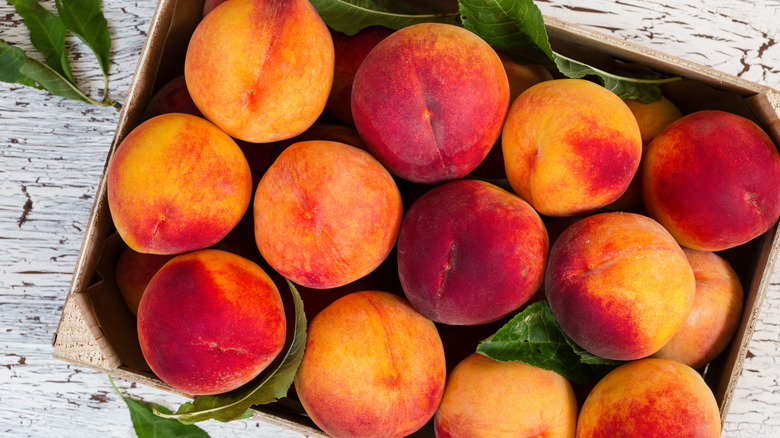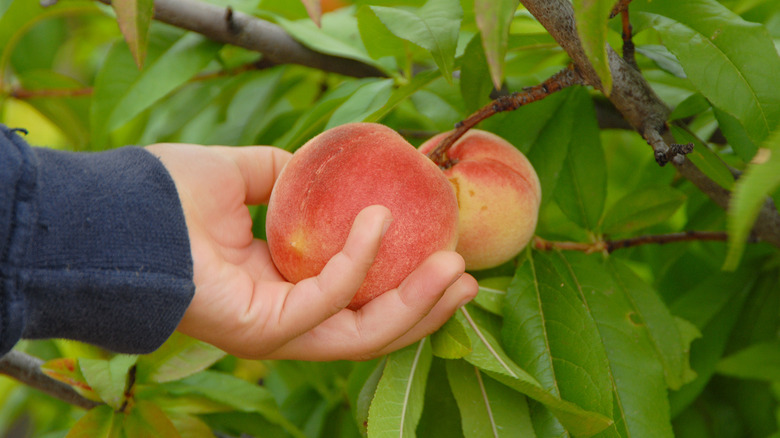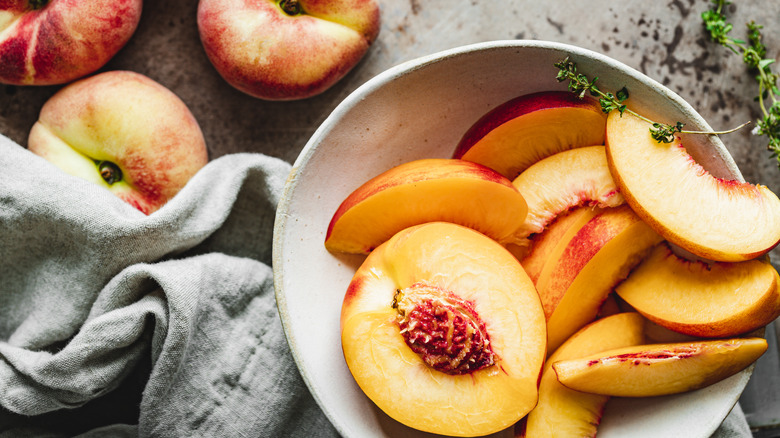The Best Way To Quickly Ripen Fresh Peaches
Imagine waking up in the mood to bake a warm, buttery peach cobbler, only to find that the fresh stone fruits that you bought just the other day are green, firm, and entirely unripe. Your juicy cobbler will have to wait for at least a couple more days, you woefully lament! But what if it didn't have to; what if you could ripen those same peaches in a matter of hours – or a day if they are particularly unripe? Thankfully, you can, and all you need to do is pop them in a brown paper bag. It's the same method you would use to ripen avocados faster, and it's also the secret to ripening guavas in a flash.
Peaches release a colorless gas known as ethylene as they mature, which is what eventually helps them ripen and soften up. Storing the peaches in a closed brown paper bag essentially traps this gas inside and enables them to ripen more quickly. However, it's important that the bag be made of paper, not plastic. The former is breathable enough to allow air to pass through without accumulating moisture inside.
It's also best to place the peaches with the stem facing down so that the round fruit doesn't get squishy. You could even pop a ripe apple or a banana into the bag, as they produce more ethylene than the stone fruit. The extra ethylene will truly speed up the process, possibly giving you ripe peaches in only a few hours.
How to shop for peaches that are already ripe
It's always best to pick ripe peaches from the get-go if you'd rather not spend valuable time trying to hasten the process later. For that, it's important to recognize certain signs of ripeness when you're out fruit shopping. For instance, the most obvious indicator is color. Ripe peaches come in all sorts of shades, ranging from red and pink to even yellow, so don't go by the fruit's overall hue. Instead, observe the area near the stem: a ripe peach will have bright yellow or golden patches there, whereas a lighter hue or a green tint is a sign that it is not yet mature. Stay away from peaches that are flat and bruised or have wrinkled skins. The latter is an indicator that the peaches were chilled and dehydrated as a result.
Another way to gauge the sweet summer fruit's ripeness is to pick it up and gently feel the area around the stem with your fingers. An unripe peach will feel firm, a soon-to-ripe one will be slightly soft, and a perfectly mature one will practically bruise at the slightest pressure. You can also tell a lot by its weight, too. Ripe peaches practically ooze with warm, syrupy juice and are naturally heavier. Scent can be a fantastic indicator as well: Peaches that are ready to eat will have a heady, sweet, and floral fragrance, whereas unripe ones will have no aroma at all.
Store those ripe peaches properly
It's imperative that you store your juicy peaches properly once you're home — you don't want them rotting before you get around to baking that warm cobbler now, do you? While unripe peaches can be left on the counter, you'll want to store them in the refrigerator once they're mature to keep them from over-ripening. However, make sure to use up the fruits quickly – within five days or so – before they dry up in the cold temperature.
Sliced peaches can also be transferred to an airtight container or a ziplock bag and stored in the refrigerator for up to four days. Consider sprinkling some citrus juice on them first, though, as cut peaches can oxidize and turn brown just as fruits like apples can. If you're worried about the citrus lacing your sweet peaches with a certain tartness, another option is to soak them in club soda for five minutes instead. After all, soda water is the key to keeping cut peaches looking fresh for days.
There's also the option of storing peeled, pitted, and sliced peaches in the freezer. Line them on a baking tray to freeze them individually first, then transfer them to an airtight bag and refreeze them for anywhere between six months to a year. Alternatively, you could preserve the stone fruits in a simple sugar syrup and then use those sweet, soft peaches in everything from desserts to salads for up to a year.



